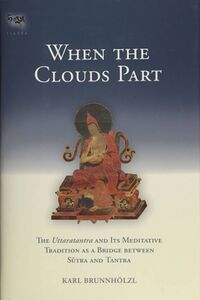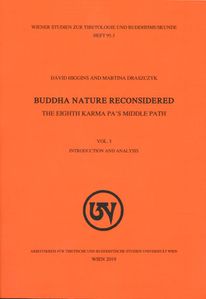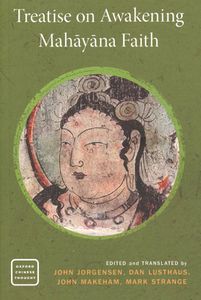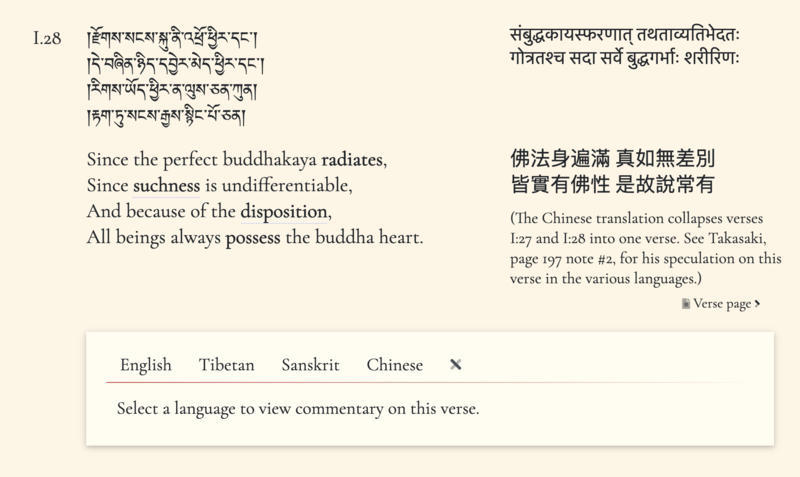Difference between revisions of "Explore"
From Buddha-Nature
((by SublimeText.Mediawiker)) |
((by SublimeText.Mediawiker)) |
||
| Line 39: | Line 39: | ||
|header=The History | |header=The History | ||
|image=https://commons.tsadra.org/images-commons/a/a3/Asanga_and_Maitreya.jpg | |image=https://commons.tsadra.org/images-commons/a/a3/Asanga_and_Maitreya.jpg | ||
| − | |content= | + | |content=The doctrine of buddha-nature became widespread in India in the first centuries of the Common Era. Although the ideas have roots that stretch back to the earliest teachings of the Buddha, the concept of tathāgatagarbha—"womb or seed of buddhahood"—was first taught in Mahāyāna communities. It was related to, but most likely distinct from both Madhyamaka and Yogācāra, the dominant schools of the Mahāyāna, emerging primarily from a corpus of scripture collectively known as Tathāgatagarbha sūtras and a commentary on them known as the Ratnagotravibhāga. As these scriptures circulated in India and were translated into Chinese and Tibetan, buddha-nature theory spread and was ultimately integrated—albeit with significant differences—into all philosophical schools and traditions of Mahāyāna Buddhism, from Japanese Zen to Tibetan Mahāmudrā. |
|watermark=Subject | |watermark=Subject | ||
}} | }} | ||
Revision as of 15:34, 9 May 2020
Explore
The Questions
Why is buddha-nature important? What would it mean to not have buddha-nature? Is buddha-nature the soul? These and other common questions about buddha-nature are outlined below, with links to readings, videos, and other material to help you explore further. New to Buddhist ideas? Click on Discover below.
The Topics
In the latter stages of its historical development in India, the idea of buddha-nature emerged as one of the most salient features of the Mahāyāna Buddhist tradition. As this form of Buddhism spread beyond the cultural milieu of ancient India, the importance of buddha-nature became evermore pronounced. In East Asian and Tibetan Buddhism, buddha-nature came to be a major keystone in the assimilation and adaptation of the Indian scriptural tradition. And, as these forms of Buddhism expanded upon that Indian heritage and developed their own literary expression of the Buddhist teachings, buddha-nature continued to be a major theme that was revisited again and again. Thus buddha-nature was weaved into the very fabric of these Buddhist traditions. Below you will find a list of pertinent topics related to buddha-nature, along with some of the major themes in which it played a crucial role.
The Ideas
Is buddha-nature already perfected and simply obscured by delusion, or is it a seed or potential that must be cultivated and perfected? Is buddha-nature a definitive or provisional teaching? Is it the mind's natural luminosity, or is it the same as emptiness? These are questions that cut to the heart of Mahāyāna Buddhist doctrine regarding the nature of enlightenment, reality, and the Path. This page introduces some of the key questions in buddha-nature theory, framed in terms of binaries.
The People
As one of the key doctrines of Mahāyāna Buddhism, buddha-nature has been taught by many of the greatest masters of India, China, Tibet, Japan, Mongolia, and Korea for well over a thousand years. Here you will find introductions to the many authors who have written on the topic, from the luminaries of Indian Madhyamaka to the great saints of Japan and Tibet. Also in this section, you will find pages for the many contemporary scholars and teachers who have written and spoken on buddha-nature. Simply filter the entire list using the search/filter bar below.
The History
The doctrine of buddha-nature became widespread in India in the first centuries of the Common Era. Although the ideas have roots that stretch back to the earliest teachings of the Buddha, the concept of tathāgatagarbha—"womb or seed of buddhahood"—was first taught in Mahāyāna communities. It was related to, but most likely distinct from both Madhyamaka and Yogācāra, the dominant schools of the Mahāyāna, emerging primarily from a corpus of scripture collectively known as Tathāgatagarbha sūtras and a commentary on them known as the Ratnagotravibhāga. As these scriptures circulated in India and were translated into Chinese and Tibetan, buddha-nature theory spread and was ultimately integrated—albeit with significant differences—into all philosophical schools and traditions of Mahāyāna Buddhism, from Japanese Zen to Tibetan Mahāmudrā.
Featured
 Increased attention to the tathāgatagarbha doctrine in the last decade has lead to significant publications and meetings on the topic of buddha-nature and related themes. Scholars in Asia, Europe, and the Americas have published new translations and studies of the foundational scriptures and commentaries, and are examining the history and literature of the doctrine. In July 2019 Tsadra Foundation partnered with the University of Vienna to bring many of these scholars together for an international symposium titled Tathāgatagarbha Across Asia.
Increased attention to the tathāgatagarbha doctrine in the last decade has lead to significant publications and meetings on the topic of buddha-nature and related themes. Scholars in Asia, Europe, and the Americas have published new translations and studies of the foundational scriptures and commentaries, and are examining the history and literature of the doctrine. In July 2019 Tsadra Foundation partnered with the University of Vienna to bring many of these scholars together for an international symposium titled Tathāgatagarbha Across Asia.Klaus-Dieter Mathes
Zhang ston Bsod nams grags pa’s Defense of Dol po pa’s Clear-Cut Distinction between Buddha Nature and the Ground Consciousness
Mathes, Klaus-Dieter. “Zhang ston Bsod nams grags pa’s Defense of Dol po pa’s Clear-Cut Distinction between Buddha Nature and the Ground Consciousness.” Paper presented at the University of Vienna Symposium, Tathāgatagarbha Across Asia, Vienna, Austria, July 2019. Video, 40:48. https://www.youtube.com/watch?v=K-ALrY63cho.; People/'gos lo tsA ba gzhon nu dpal, Key Terms/trisvabhāva, Key Terms/pariniṣpannasvabhāva, Key Terms/paratantrasvabhāva, Key Terms/parikalpitasvabhāva, Key Terms/Jonang, Texts/Laṅkāvatārasūtra, Texts/Śrīmālādevīsūtra, People/Karmapa, 3rd, Texts/Tathāgatagarbhasūtra, Texts/Anūnatvāpūrṇatvanirdeśaparivarta, People/Dol po pa, Texts/Mahāyānottaratantraśāstropadeśa, Texts/Ratnagotravibhāgavyākhyā, Key Terms/ālayavijñāna, Key Terms/Yogācāra, People/Zhang ston bsod nams grags pa, Key Terms/gzhan stong, Texts/Ratnagotravibhāga Mahāyānottaratantraśāstra
Ngawang Jorden
Revisiting Gorampa on Buddha Nature
Jorden, Khenpo Ngawang. "Revisiting Gorampa on Buddha Nature." Paper presented at the University of Vienna Symposium, Tathāgatagarbha Across Asia, Vienna, Austria, July 2019. Video, 45:05. https://www.youtube.com/watch?v=wmhgtw5HwCE.; Key Terms/rang stong, Key Terms/śūnyatā, Key Terms/trisvabhāva, Key Terms/pariniṣpannasvabhāva, Key Terms/paratantrasvabhāva, Key Terms/parikalpitasvabhāva, Key Terms/paramārthasatya, Key Terms/saṃvṛtisatya, Key Terms/Jonang, Key Terms/Sakya, People/Dol po pa, People/Rong ston shes bya kun rig, Texts/Sdom gsum rab dbye, People/Red mda' ba gzhon nu blo gros, People/Go rams pa bsod nams seng ge, Key Terms/Madhyamaka, Texts/Dharmadhātustava, People/Nāgārjuna, Debates / Debate, Key Terms/gzhan stong, Topics/History of buddha-nature in Tibet, Topics/Two Truths
Jacqueline Stone
From Buddha Nature to Original Enlightenment “Contemplating Suchness” in Medieval Japan
Stone, Jacqueline. "From Buddha Nature to Original Enlightenment: 'Contemplating Suchness' in Medieval Japan." Paper presented at the University of Vienna Symposium, Tathāgatagarbha Across Asia, Vienna, Austria, July 2019. Video, 47:26. https://www.youtube.com/watch?v=1zXXWsD39hc.; Key Terms/dharmadhātu, Key Terms/neyārtha, Key Terms/nītārtha, Texts/Saddharmapuṇḍarīkasūtra, Key Terms/tathatā, Key Terms/dharmatā, People/Shinran, People/Genshin, Topics/History of buddha-nature in China, Topics/History of buddha-nature in Japan, Topics/The doctrine of buddha-nature in Japanese Buddhism, Topics/Tien Tai, Key Terms/original enlightenment, Disclosure model
In this wide-ranging video interview, Karl Brunnhölzl discusses buddha-nature and the key topics related to it. He begins by defining buddha-nature and then moves on to discuss such topics as the debate that the doctrine has generated, the concepts of emptiness and luminosity, and how buddha-nature relates to Vajrayana practice.
On this site
From the experts
In this interview Professor Klaus-Dieter Mathes discusses buddha-nature and the key ideas behind it, the controversies it generates, and some of the related Buddhist philosophy in comparative perspective.
In this video interview Wulstan Fletcher discusses Mipham's and Longchenpa's approach to buddha-nature as well as his personal experiences with buddha-nature teachings and how they have influenced his practice.
In this video interview Elizabeth Callahan discusses the key terminology that is used when speaking of buddha-nature. She explains the term ordinary mind and elaborates on the meaning of buddha-nature.
Other Interviews
Ringu Tulku
Ringu Tulku Interview on Buddha-Nature
Ringu Tulku. “Ringu Tulku Interview on Buddha-Nature.” Interview by Marcus Perman. Produced by Tsadra Foundation Research Department, October 10, 2019. Audio, 1:00:17.; People/'jam mgon kong sprul, People/Sgam po pa, Texts/Dam chos yid bzhin gyi nor bu thar pa rin po che'i rgyan, Topics/Defining buddha-nature, Topics/Sentient beings, Topics/The doctrine of buddha-nature in Tibetan Buddhism, Topics/Third Turning, Topics/Debate(s), Texts/Ratnagotravibhāga Mahāyānottaratantraśāstra
Tokpa Tulku
Tokpa Tulku Interview on Buddha-Nature
Tokpa Tulku. "Tokpa Tulku Interview on Buddha-Nature." Produced by the Tsadra Foundation Research Department, April 22, 2019, Kathmandu, Nepal. Audio, 25:08.; Key Terms/rang stong, Key Terms/gzhan stong, Topics/The doctrine of buddha-nature in Tibetan Buddhism, Topics/Debate(s), Texts/Ratnagotravibhāga Mahāyānottaratantraśāstra
Publications
Study the sources
The seeds of buddha-nature teachings are sprinkled throughout the sutras and tantras of the Buddhist canon. A core group of scripture that initially taught buddha-nature known as the tathāgatagarbha sūtras date between the second and fourth centuries. These include the Tathāgatagarbhasūtra, the Mahāparinirvāṇasūtra, the Śrīmālādevīsūtra and several others. The famous Laṅkāvatārasūtra was also important for buddha-nature theory. In Tibetan Buddhism the late-Indian treatise Ratnagotravibhāga Mahāyānottaratantraśāstra, or "Gyu Lama" as it is known in the Tibetan, serves as a major source for buddha-nature. In East Asia the Awakening of Faith in the Mahāyāna (大乗起信論) was the most influential treatise in spreading buddha-nature theory.Explore the root verses
Traditional expositions
The Fourteenth Dalai Lama Tenzin Gyatso
Discourse on the Uttaratantra by The 14th Dalai Lama in Holland
Dalai Lama, 14th. "Discourse on Uttaratantra." Pt. 1 of 4. Interpreted by Alexander Berzin, Filmed May 1986 in Holland. Produced by Study Buddhism. Video, 1:37:22, https://www.youtube.com/watch?v=LsiVRQ3T6EY.; Key Terms/āgantukamala, Key Terms/prabhāsvaracitta, Texts/Ratnagotravibhāga Mahāyānottaratantraśāstra
Ringu Tulku
Buddha Nature: A Talk by Ringu Tulku Rinpoche
Ringu Tulku. "Buddha Nature." Pt. 1 of 3. Produced by and filmed at Karma Sonam Dargye Ling Temple, December 1, 2015. Video, 1:37:22. https://www.youtube.com/watch?v=e8BD50jtFgg.;
Kirti Tsenshab
Buddha Potential 1: Uttaratantra by Kirti Tsenshab Rinpoche at Land of Medicine Buddha, 2003
Tsenshab, Kirti. "Buddha Potential 1: Uttaratantra by Kirti Tsenshab Rinpoche." Pt. 1 of 9. Filmed at Land of Medicine Buddha, Soquel, CA, 2003. Video, 1:27:14. https://vimeo.com/136634699.; Texts/Ratnagotravibhāga Mahāyānottaratantraśāstra
Khenpo Sodargye
Mahayana Uttaratantra Shastra: Taught by Khenpo Sodargye, May 2019
Khenpo Sodargye. "The Mahayana Uttaratantra Shastra." Pt. 1 of 15. In Chinese with English translation. Produced by Khenpo Sodargye's team, May 2019. Video, 1:00:17. https://www.youtube.com/watch?v=H4OiLLo1e_Y.; Key Terms/Nyingma, Texts/Ratnagotravibhāga Mahāyānottaratantraśāstra
Teachings on the Uttaratantra by Gyumed Khensur Rinpoche
Khensur, Gyumed. "Uttaratantra (Buddha Nature)." Pt. 1 of 16. Streamed live on August 13, 2016 by Do Ngak Kunphen Ling and the Mahayana Sutra and Tantra Center of New Jersey. Video, 1:49:55. https://www.youtube.com/watch?v=mIeSENCwGzI.; Texts/Ratnagotravibhāga Mahāyānottaratantraśāstra
Orgyen P'huntsok
Tulku Orgyen Phuntsok Buddha Nature Class: Teachings on the Uttaratantra
Phuntsok, Tulku Orgyen. "Buddha Nature." A Six-Part Teaching on the Uttaratantra Shastra. Pt. 1 of 6. Produced by the Odiyana Institute, 2018. Video, 1:20:20. https://www.youtube.com/watch?v=BtQ5xyMtlAg.; Texts/Ratnagotravibhāga Mahāyānottaratantraśāstra





